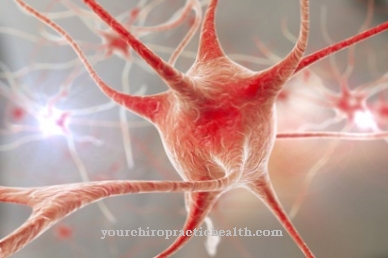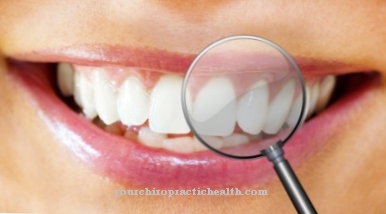With the propulsive peristalsis the smooth muscles transport food from the esophagus to the rectum. The wave-shaped and locally synchronized contractions are subject to modulation by the sympathetic and parasympathetic nervous systems. Muscle reflexes also play a role in propulsive peristalsis.
What is propulsive peristalsis?

In the hollow organs of the human body there is a certain type of muscle movement that is controlled by the autonomic nervous system. This muscle movement is also known as peristalsis. It corresponds to a locally synchronized contraction of muscle cells of the smooth muscles.
The wave-like phases of contraction and relaxation are reminiscent of the movement of earthworms, for example, and affect the longitudinal and circular muscles. Hollow organs with such a movement pattern include the esophagus, ureter, fallopian tube and uterus as well as the stomach and intestines.
In addition to orthograde peristalsis for transport and retrograde peristalsis to reverse the direction of transport, the gastrointestinal tract operates both non-propulsive and propulsive peristalsis. The latter is used for the further transport of hollow organ contents and is attached to the enteric nervous system, which consists of autonomous cellular networks in the intestinal and stomach walls and is modulated by the vegetative nervous system.
Propulsive peristalsis is therefore a contraction movement that occurs unconsciously and in the human organism only affects the section between the esophagus and the large intestine. The non-propulsive peristalsis does not serve the further transport, but the mixing of the hollow organ contents and is only present in the intestine.
Function & task
The intestine is lined with smooth muscles in the intestinal walls. The same goes for the esophagus or stomach. In vertebrates, smooth muscles support all internal organs. The muscle tissue is arranged in layers with different strokes. It consists of single cells, 20 to 500 μm in size, which branch out in a spindle shape and are plasma-rich. The functional order presumably consists mainly of actin filaments and myosin filaments. The actin filaments are loosely anchored in the cell membrane as loose bundles. At their free ends they are linked by auxiliary proteins such as desmin. Their contraction is triggered by the flow of Ca2 + ions into their cytoplasm. The subsequent phosphorylation in the myosin head is achieved by myosin kinase.
The degree of shortening of the smooth muscle cells is extremely high. The fatigue is extremely low. In theory, the smooth muscle layers can be controlled directly by the autonomic nervous system. The muscle cells are not innervated, but receive stimulation signals hormonally. The propulsive peristalsis of these muscles transports food to the rectum and thus contributes to the excretion of indigestible, unusable and processed food components.
The muscle contraction corresponds to a ring-shaped contraction of the smooth muscles. The contraction continues continuously and wave-like in one direction. Contraction phases alternate locally synchronized with relaxation phases. Both the natural rhythm of the muscles and locally spreading reflexes contribute to the movement. These reflexes are local muscle reflexes that are subject to monosynaptic interconnection and thus have their efferent and afferent pathways in the same organ.
The parasympathetic nervous system has a stimulating effect on the modulation of propulsive peristalsis. Its antagonist, the sympathetic nervous system, exerts an inhibiting influence. The parasympathetic and sympathetic nervous systems are part of the autonomic nervous system, which, in addition to the internal organs, primarily modulates the blood circulation. It is thus responsible for the control of all vital functions. The propulsive peristalsis and with it the organ activity of the stomach, intestine and esophagus is controlled extremely finely by the two opponents sympathetic and parasympathetic.
You can find your medication here
➔ Medication for diarrheaIllnesses & ailments
In particular, the propulsive peristalsis of the intestine is often affected by symptoms. For example, in the context of paralytic ileus, which corresponds to a form of intestinal obstruction. The propulsive and non-propulsive peristalsis of the intestine comes to a standstill in this disease due to a functional disorder. Ultimately, this means that there is intestinal paralysis. Because of the interrupted intestinal passage, chyme and feces build up in the intestine.
Paralytic ileus is most commonly caused by inflammation in the abdomen. In addition to appendicitis, gallbladder inflammation or pancreatitis can also trigger the phenomenon. Possible causes are also vascular occlusions and various drugs. The most common drug triggers are opiates and antidepressants.
On the other hand, the propulsive peristalsis of the intestine can also cause symptoms through increases. This is the case, for example, with mechanical ileus. In the context of this phenomenon, the intestinal passage is disturbed by a mechanical obstacle. In addition to foreign bodies, balls of feces and gallstones, intestinal entrapment and entanglement are possible mechanical obstacles in the intestinal passage. The peristalsis is exaggerated in this phenomenon, especially in the intestinal section in front of the obstruction.
An extreme case of mechanical ileus is the so-called intestinal obstruction, which, in addition to vomiting of faeces, is characterized by a bacterial imbalance and the resulting inflammatory processes in the intestine.
Irritable bowel syndromes also disrupt intestinal peristalsis. This chronic dysfunction can be accompanied by diarrhea and constipation, stomach pain, a feeling of fullness or a flat stomach. The condition of those affected worsens with stress. Therefore, irritable bowel syndrome is counted among the psychosomatic diseases.
Propulsive peristalsis of the esophagus or the stomach can also be subject to disturbances, for example in the context of injuries or paralysis of the muscles located there. However, these symptoms are far less common than disturbed intestinal peristalsis.
























.jpg)



